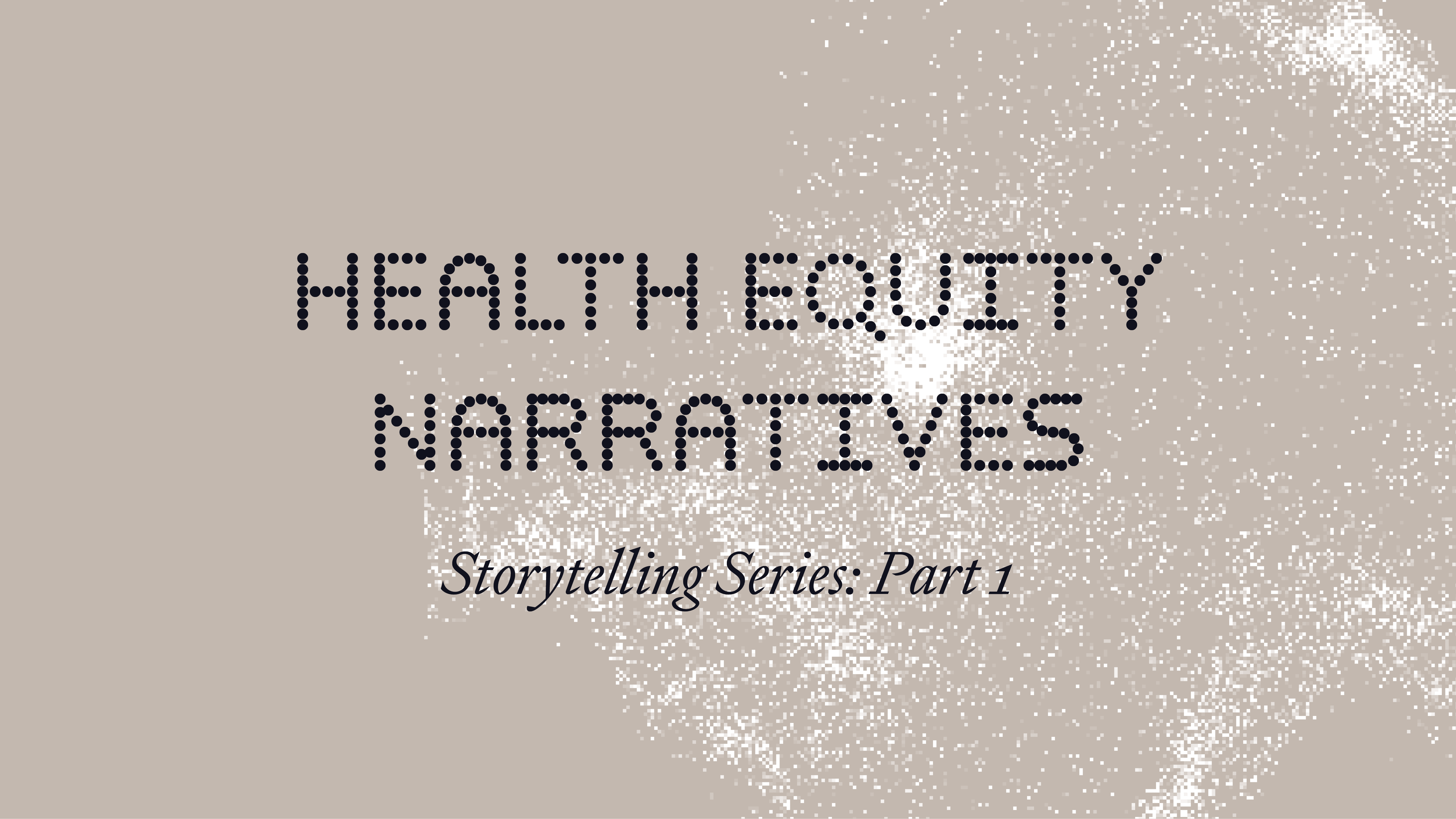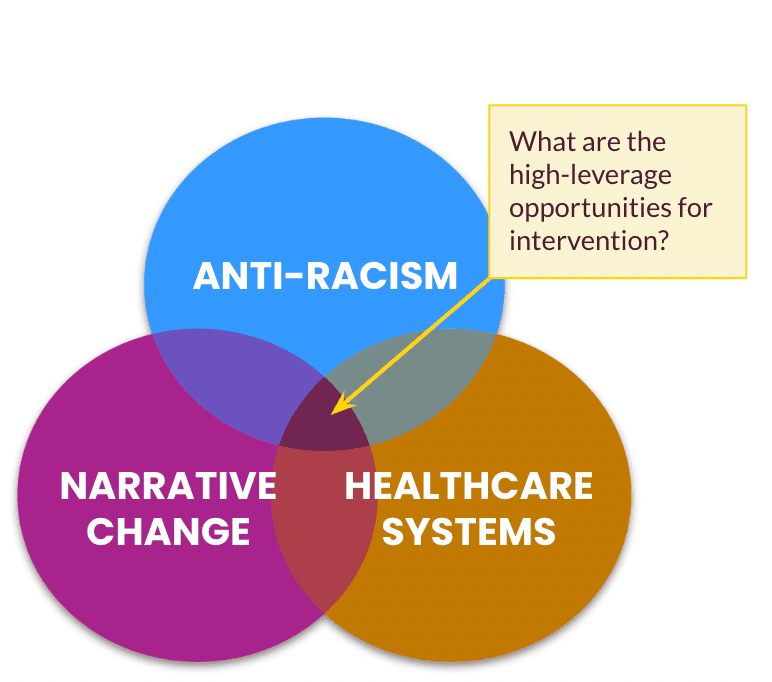Four Principles For Building Power in Media


2023-01-20
Over the last year, Harmony Labs has been developing an audience-narrative architecture to help the Robert Wood Johnson Foundation (RWJF) and its partners find “narrative strategies” and actual storytelling that would activate people in the U.S., especially healthcare professionals, to dismantle structural racism in America’s healthcare and public health systems. The foundation of this work was research on audiences and the health equity narrative landscapes they inhabit. This initial research helped surface the most promising opportunities for content testing and validation, from which our project partner Story Strategy Group convened groups of professional storytellers, anti-racism experts, community leaders, and content strategists to develop new stories that might transport audiences toward a target narrative of health equity. This piece is one in a three-part series from some of the subject matter experts and storytellers who worked on this project. You can explore the full findings here.
This post was originally published on Medium.
My first substantive exposure to the field of narrative strategy was as part of the racial justice movement when I worked at Race Forward. In 2010, we published “Moving the Race Conversation Forward,” a report documenting case studies and successful interventions on how the nation was talking about race. One particular case study featured Race Forward’s “Drop the I-Word” campaign, which called for eliminating the word “illegal” when referring to immigrants.
Our goal was to reframe immigration policy as a matter of human dignity rather than solely one of law and order. This work coincided with the heightened political, cultural, and artistic activity of DREAMers and other activists who were popularizing the word “undocumented” in its place. The campaign was successful on many levels, most notably by getting the Associated Press (AP) to remove “illegal immigrant” from its stylebook in April 2013.
To support the development of such a report, my boss, Race Forward’s then-Executive Director, Rinku Sen (now Executive Director of Narrative Initiative), convened activists, communications experts, and other narrative thinkers and practitioners across a variety of social movements and created a space of exchange — where people of different areas of expertise could think and share together on the fundamentals of this emerging field.
That convening — and the Black Male Re-Imagined convenings hosted by the Campaign for Black Male Achievement — lit a fire within me regarding the power and possibilities of narrative strategy as a means for advancing racial justice.
Reflecting back on that time in the 2010s, there was a particular dynamism taking place across social movements. We wanted to “change the world,” but we were realists, too — we didn’t presume we’d be alive to see it change. But to our surprise, we were living through inflection points for history-making, fully activated, globally networked, social movements: immigration reform, Arab Spring, Occupy Wall Street, and #BlackLivesMatter. More than what we’d read in history books or the firsthand accounts we’d listened to at the feet of Movement Elders — we were seeing systems change.
The power of this witness changed the course of many lives — including mine.
By 2015, I left Race Forward, feeling called back into supporting leaders across these social movements as a movement practitioner. And, even though I had already been working to advance racial justice, as a Black woman, the burgeoning Movement for Black Lives provoked me even further into this work. I felt an inner pull to name and attend to the specific problem of anti-Black racism. So, while spending the next few years consulting to social movements and building racial justice capacity within the social sector, I was also ideating and incubating a solution to the U.S. racial caste system that called out anti-Blackness as a structural, and narrative, problem.
A few years later — on Juneteenth 2019, and 400 years after the first enslaved Africans touched this Turtle Island — I launched Beautiful Ventures, as a “narrative social change enterprise” that supports and centers Black story-tellers and story-lovers committed to retiring, reimagining, and replacing anti-Blackness in popular culture and public discourse.
Less than a year after Beautiful Ventures’ launch, on May 25, 2020, George Floyd was murdered. Our country and the globe was again reawakened to the Movement for Black Lives’ call to rid our world of anti-Black racism.
During that summer of what would be called a national “Racial Reckoning,” leading narrative strategist and consultant colleague Liz Manne contacted me and asked if I’d be interested in joining a team she was pulling together — with support from the Robert Wood Johnson Foundation — “to provide actionable, scale-ready, research-informed storytelling and narrative strategies to advance racial equity in health care and health systems.” Joining the team would mean I’d be able to see how the researchers, funders, and students of the meta-narratives who shape our national conversations influence our narrative ecosystem. It would also allow me to leverage my own emerging narrative work with my process design, systems thinking, and racial equity chops in support of a more racially just healthcare system — in the middle of a once-in-a-century global pandemic. Yes, I was interested!
On the project, I held two key roles: as an internal advisor and coach to our consulting team regarding its own anti-racist practice, and as lead process facilitator for a group of health equity and narrative experts who would serve as advisors and co-creators on the project. Here, I share reflections on my work in this latter role.
My charge was to convene this group of health equity and narrative leaders and facilitate a process where they could imagine liberatory stories and narrative ideas that might move or activate people towards a racially equitable and inclusive healthcare system.
A separate creative team, composed of writers and designers, was then on deck to translate and distill those ideas into actual stories, in a form suitable for testing for engagement and persuasion effects. We were interested in whether people would consume the stories we wanted to tell and if our stories successfully moved them in a positive direction.
To support our process, I divided up the work into several phases, which I detail below:
Early on, our consulting team struggled to find a point of departure for launching our uniquely multi-disciplinary work — which sought to bring together research, strategy, and creative. The scope seemed at the same time to be both very broad and very nuanced. From my work of leading multi-stakeholder collaborative change processes over the last 15 years, I knew that we had to go to “the field” for this direction. This was not a matter for us as consultants to decide. It needed to be identified through the collective discernment of thinkers and practitioners from not one but three fields of study, practice, and engagement that collectively could help us identify the highest lever opportunities for intervention in the overlapping spaces of health systems change, narrative strategy, and anti-racism practice.
While it was not our job as consultants to decide the key areas of narrative interest, it was indeed our role to design a process by which field experts could engage that assignment with integrity and rigor. My hope was that their analyses would bring some much-needed boundaries to the bold and broad challenge placed before us.

For this task, I called upon the process chops of my excellent colleague and principal design partner, Curtis Ogden, a Senior Associate with the Interaction Institute for Social Change, where we both cut our teeth in collaborative process design and facilitation, and where I now serve on its Board of Directors.
With Curtis’ guidance, we conducted two immersive work sessions for a group of eleven leading strategists and practitioner experts in our three focus fields: health systems change, narrative strategy, and anti-racism practice. The group collaboratively worked to identify the storytelling areas with the greatest potential to challenge and change structural racism in health systems by engaging, informing, persuading, and motivating both the general public and people working within the healthcare system. What we came up with together are these six promising areas of opportunity for narrative intervention that can most shift the system towards equity (which we referred to as our “Six Strategic Areas of Narrative Focus”):
With the most promising areas of narrative focus now identified, we moved on to the next phase of our work: putting in place a process to select a group of practitioners — which we dubbed the Narrative Power Team (NPT) — who could develop stories and story elements for use in testing by our research colleagues. Personally, I felt the weight of responsibility for facilitating a group of experts, activists, and community leaders in a way that would not be extractive, boring, or a waste of anyone’s time. While I always aim to avoid this in my consulting engagements, I was particularly adamant given the double pandemics we were operating within — COVID-19 and COVID-1619. And — especially given my embodied reality as a Black woman, I couldn’t — wouldn’t — bear it.
First, we created a team charter — outlining the purpose, composition, and deliverables for the NPT’s eventual work:
The purpose of the Narrative Power Team is to contribute to the SSG Team’s production of research-tested content and insights that will inform the development of narrative strategies and tools that will break through the racialized status quo in the U.S. healthcare system towards one that values all people equally, recognizes and rectifies historical and ongoing injustice, provides resources according to need, and is representative of all the people it serves.
The Narrative Power Team will consist of 7–10 diverse experts, including health equity advocates, medical practitioners, community leaders, anti-racism practitioners, storytellers, content researchers, systems change agents, and people with relevant lived experiences.
Next, through a stakeholder analysis process, we extended invitations to a small group of individuals and selected the following as our NPT dream team: Dr. Karen Craddock, The Wellness Collaborative; Safe Harbor Chair for the People of the First Light; Darlene Marie Mortel Edouard, Ole Greens Group; Children’s Media Consultant; Dr. Kareem Edouard, Ole Greens Media Group and Drexel University; Leah Salgado, IllumiNative; Charles Stephens, Counter Narrative Project; Cristina Uribe, Collaborative for Reproductive+Gender Equity; Dr. Monica Wang, Health Equity Consultant; Leseliey Welch, Birth Detroit; and Rev. Dr. Gloria White-Hammond, Bethel AME Church — Boston; Harvard Divinity School. Alexis Levy, a senior communications officer, and Dr. Melody Tulier, program officer — both of the Robert Wood Johnson Foundation — also contributed to the work of the NPT.
Once all members were recruited and confirmed — and with the support of expert content manager Glenn Johnson — the Health Equity Narrative Power Team was launched.
The NPT met five times in Spring 2022:
Meeting #1: built relationships and oriented members. At our initial meeting, we built relationships as a new team by sharing the values and people who are foundational to our lives and work; reviewed and adopted the NPT Charter, which included the the key goals, work streams, and team roles for the Health Equity Narrative Project; clarified how this team would interface with researchers, creatives, and other contributors to the project; and we reviewed and provided feedback on the Six Strategic Areas of Narrative Focus surfaced previously.
Meeting #2: aligned understanding of Areas of Narrative Focus. At the NPT’s second meeting, we continued to align our interpretative understandings of the Areas of Narrative Focus — identifying what resonated and providing additional insights on how these areas play out currently; we also reviewed key features of the body-centered psychology of Resmaa Menakem and others — particularly how his notion of “white body supremacy” might inform the team’s creative work. Lastly, we began the work that would take us through the end of our process — ideating scenarios that depicted the racist and racialized status quo of the healthcare systems and what a more just system might look like.
Meeting #3: reviewed narrative change strategy and began creative ideation. We spent time during our third meeting collectively reviewing key terms common to the project and to the field of narrative strategy: story, narrative, narrative strategy, and scenario — just to make sure we were on the same page. Then, before beginning the work of developing scenarios based on the Areas of Narrative Focus, we watched clips from “The Color of Care” — an Oprah Winfrey produced documentary that had just premiered on The Smithsonian Channel.
Meeting #4: continued creative ideation. Like the previous meeting, this meeting was designed to layer on a few more conceptual resources to serve as intellectual and creative fodder for the NPT’s work of developing and refining scenarios which depict the current racist and racialized status quo in the U.S. healthcare system. We shared the Norman Lear Center’s seminal article Narratives as a Tool: Shifting Mindsets at Scale, and reviewed the 4 Levels of Racism Framework, a staple of racial equity pedagogy. We also spent a good amount of time working on our scenarios — individually, in small groups, and as a large group.
Meeting #5: finalized creative scenarios. In our final meeting together, NPT members finalized the scenarios they had been developing, reviewed the vision we are using for this project (incorporated from a prior health equity project, also sponsored by the Robert Wood Johnson Foundation), and actively went through each of the scenarios to ensure that the “liberatory narrative elements” infused in them either pointed towards or would effectuate that vision in the future.
From these work sessions, members of the NPT identified thirteen scenarios, many of which include liberatory narrative elements developed from the team members’ personal, professional, and community-based experiences, with one from a current event story reported by the news media:
The NPT’s ideas were then handed off to and picked up by the project’s creative team, which transformed our ideas and scenarios into actual stories that real people saw and reacted to.
Here are just a few examples of some of the Facebook ads — mini stories developed for the purposes of testing — that were created from or inspired by the scenarios and liberatory narrative elements developed by the NPT.
Some stories that were refined during the testing process moved audiences to agree that a problem exists in our healthcare system (and who has access to it), that we should change it, and that such change is possible.
You can read the project research report from Harmony Labs to learn more about the testing process and findings, including recommendations for advocates working to advance health equity and justice.
Without a doubt, the opportunity to shepherd this amazing group of change agents and witness their utter brilliance, soulfulness, and commitment during one of the most challenging periods in our lifetimes — has been one of the deep honors of my professional life. I cannot thank the members of this august group enough — the Narrative Power Team — for their trust, vulnerability, and for the amazing creative juices that mixed and flowed between us. I hope it was also a balm for each of them, as it was for me, during these particularly tough times we’ve been blessed to live through these last few years.
My deep thanks to Liz Manne, and the teams at Story Strategy Group and Harmony Labs, for this opportunity to collaborate, learn, and contribute to the narrative strategy field’s work on one of the most important issues of our time.



